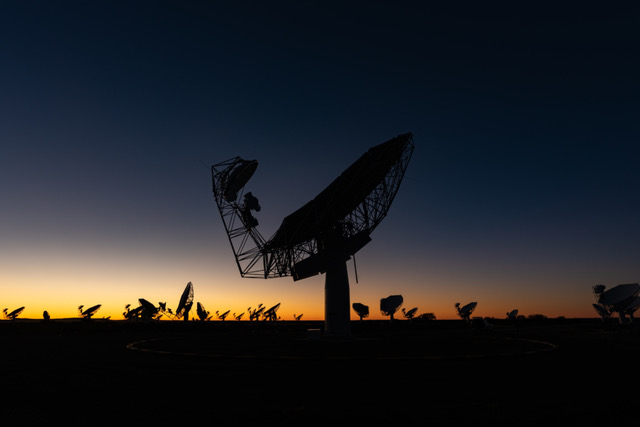Anna-Lena Rüland, Nicolas Rüffin, Katharina Cramer, Prosper Ngabonziza, Manoj Saxena, Stefan Skupien

Photo credit: South African Radio Astronomy Observatory (SARAO)
Science diplomacy, broadly defined as all activities at the intersection of science policy and international relations, has become somewhat of a buzzword during the last 10 years. Initially coined and put on the international agenda by prominent US-American policymakers and institutions, it has by now gained popularity across the globe and made its way into the scholarly discourse. Yet, so far, much of the literature on the topic has sidelined the science diplomacy practices, capacities and experiences of the Global South. This has only begun to change quite recently, reflecting a broader trend to better describe and understand the role of the Global South in international relations. In line with this trend and as part of a special issue on science diplomacy in the Global South, we – a research team spread over three continents – analyzed the interests of Southern emerging powers in a distinctive science diplomacy setting, namely in what we dub ‘intergovernmental science organizations’ (IGSOs).
IGSOs as a science diplomacy arena
What are IGSOs and why are they an important science diplomacy arena for Southern actors? Essentially, IGSOs resemble international organizations (IOs) like the United Nations. They are founded on intergovernmental treaties, have executive bodies and a council, in which governmental and scientific representatives negotiate all matters of fundamental importance to the organization. Just like other IOs dominate the issue areas that they oversee, IGSOs form central nodes in the fabric of the scientific fields and communities that they serve. At the same time, they are of high interest to policymakers because while IGSOs often have hefty price tags, they promise considerable political prestige for the involved countries, not least because IGSOs are seen as critical in addressing many pressing global challenges. In recent decades, some emerging powers of the Global South have joined several existing IGSOs in the Global North and have helped establish new ones in the Global South. Although the Global South is increasingly visible in the global IGSO landscape, we know surprisingly little about its role and interests in IGSOs. In a recently published study, we addressed this blind spot by comparing Southern participation in four different IGSOs, each characterized by a unique configuration of member countries, institutional set-up and research field. Specifically, we focused on:
- The European Organization for Nuclear Research,
- The International Thermonuclear Experimental Reactor,
- The Square Kilometer Array, and
- The African Light Source Project.
In each case, we concentrated on the participation of one particular Southern emerging power and examined which interests it pursues in the IGSO under investigation. We also addressed the question of under which conditions emerging powers of the Global South are likely to achieve their objectives in IGSOs. In doing so, we used a broad institutional perspective and a pragmatic conceptualization of science diplomacy.
Southern emerging powers in IGSOs
In our study, we found that Southern emerging powers pursue a multitude of scientific and political objectives in and through IGSOs. Most of these interests resemble those that established science nations of the Global North aim to advance through and in IGSOs. Specifically, our comparative analysis showed that the key priority for most emerging powers of the Global South is to strengthen their science and technology capacities through IGSOs. Moreover, some Southern emerging powers get involved in IGSOs to (re-)establish connections between their political and scientific communities as well as their global counterparts. Finally, participating in IGSOs allows countries of the Global South to strengthen their burgeoning reputation as regional science and technology powers and to settle regional political and scientific rivalries.
Our analysis further revealed that emerging powers of the Global South are likely to achieve their objectives in IGSOs if four, in some cases five, conditions are met. These conditions relate to a country’s scientific community, domestic politics, industrial capacities, geographic location and an IGSO’s institutional maturity.
The institutional maturity of an IGSO conditions which interests countries of the Global South can pursue because in established IGOSs like CERN, founding members, typically from the Global North, have successfully cemented their institutional rights and privileges. Countries of the Global South are rarely among the founding members of matured IGSOs because when these were set up after World War Two few countries of the Global South had the economic or scientific capacity to participate. As a result, Southern actors often lack the institutional rights and privileges to shape important decisions in established IGSOs.
To get involved in mature IGSOs but also to found new IGSOs, an active and outspoken scientific community is often needed. Such a community is crucial because it can strengthen a country’s reputation in science and technology as it gets involved in an IGSO on an ad hoc basis. Moreover, a well-connected scientific community can lobby local and foreign policymakers as well as scientists to support the establishment of an IGSO. Continuous domestic political support and long-term national contributions, in-cash and in-kind, are equally important for countries of the Global South to attain their political and scientific objectives in IGSOs because such contributions signal commitment to other members and can be leveraged during diplomatic negotiations. However, given that many countries of the Global South face more acute political, economic, and human resource constraints than countries of the Global North, it can be difficult for them to provide the necessary in-cash and in-kind contributions for IGSOs. For similar reasons, there are only few countries of the Global South that have the industrial capacities to take on substantial contracts for the large infrastructures that many IGSOs rely on. In contrast to these scientific, industrial, and political capacities which are needed for almost all IGSOs, a country’s geographic location only comes into play if an IGSO has specific climatic or environmental requirements. This is typically the case for IGSOs in the field of astronomy.
Lessons learned
North-South asymmetries continue to shape IGSOs, particularly those with a high degree of institutional maturity. Given the great economic, scientific and human capital requirements of IGSOs – be they matured or not – only few Southern actors can afford to participate in this type of science diplomacy arena. What further complicates matters is that, much like other IOs – or almost any formal organization for that matter – IGSOs generally resist change.
Yet not all is lost for IGSO newcomers. Our analysis indicates that there are two strategies that could help diplomats and scientists of Southern emerging powers mitigate North-South asymmetries in IGSOs. First, it may prove useful for countries of the Global South to adjust their science diplomacy objectives to the institutional maturity of an IGSO. To do so, they are well advised to map out their objectives before getting involved in an IGSO. For instance, if a Southern country’s goal is to take up a leadership position, then it should seek to join an IGSO as early as possible, ideally as a founding member, as this will endow them with the necessary institutional privileges and rights to actively shape an IGSO. Should a Southern country’s objective be less ambitious, for example because it ‘only’ wants to strengthen its science and technology capacities, it may suffice for it to get involved in an IGSO at a later stage. Second, it could prove useful for Southern actors to invest strategically into IGSOs instead of taking a scattergun approach to IGSO funding. In practice, this means that countries of the Global South should fund IGSOs in research areas that are of high interest to them or in which they have a competitive advantage. This also increases chances that they can meet the political and economic commitments to an IGSO.
It goes without saying that our study only provides a small snapshot of Southern science diplomacy. To get a more holistic understanding of Southern science diplomacy, additional studies on, from and with the Global South are needed. We call on the science diplomacy community to contribute to this emerging line of research and underline its potential to turn science diplomacy into a more inclusive field of study that recognizes its multiple and diverse foundations.
About the authors:
Anna-Lena Rüland, PhD researcher at Leiden University
Nicolas Rüffin, Research fellow at the University of Bonn
Katharina Cramer, Senior fellow at the University of Bonn
Prosper Ngabonziza, Assistant Professor at Louisiana State University
Manoj Saxena, Visiting researcher at King’s College London
Stefan Skupien, Visiting researcher at the WZB Berlin Social Science Center
References:
Büyüktanir Karacan D and Ruffini P-B (2023) Science Diplomacy in the Global South – An Introduction. Science and Public Policy. Online first. https://doi.org/10.1093/scipol/scad028
Rüland A-L, Rüffin N, Cramer K, et al. (2023) Science Diplomacy from the Global South: The Case of Intergovernmental Science Organizations. Science and Public Policy. Online first. https://doi.org/10.1093/scipol/scad024
N.i. (2021) Hidden in Plain Sight. Nature Reviews Physics 3(11): 721-721.
SESAME (2004) Foundation of a Synchrotron Light Source in the Middle East. Available at: https://www.sesame.org.jo/about-us/historical-highlights/2004-foundation-of-a-synchrotron-light-source-in-the-middle-east (accessed 28 June 2023).
This blog post was initially published on Europe of Knowledge blog.

